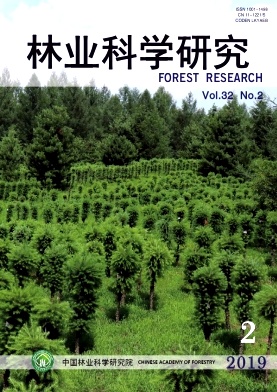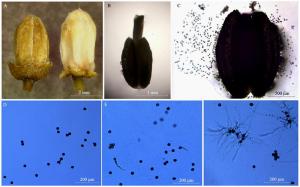-
香椿(Toona sinensis(A. Juss.) Roem.)楝科香椿属,我国特有树种,具有树干通直、速生、木材纹理好、材性优良、耐腐蚀、易于加工等优点[1]。香椿广泛分布于我国除新疆、内蒙古之外的22个省区[2],种质资源丰富,对香椿的研究多集中在育苗栽培、营养成分和功效及作为木本蔬菜时的保鲜贮藏等方面[3-5],在香椿林木改良方面的报道较少[6]。花粉是杂交育种中植物遗传信息的重要载体,在育种过程中,不论是授粉母本,还是父本,都需要明确育种材料花粉的萌发能力[7-8],但对香椿花粉离体萌发及低温贮藏花粉生活力等方面的研究未见报道。
黄烈健等[9]综述了多种林木花粉生活力检测的方法,赵鸿杰等[10]指出,离体萌发法分析花粉生活力精确性更高,本试验选用该法分析香椿花粉的生活力。在花粉离体萌发过程中,培养温度和时间是2个重要的培养条件[11]。培养温度过高,花粉易失活;温度过低,花粉萌发缓慢。此外,花粉离体萌发过程需要时间,培养时间过短,花粉未充分萌发;时间过长,花粉管会破裂,统计的萌发率均偏小[12]。适宜的培养温度、培养时间才能更准确地反映花粉生活力,而关于香椿花粉相关的研究未曾报道。影响花粉生活力的因素是什么及不同生活力花粉外部形态有何差异?耿兴敏等[13]指出,花粉含水率是影响花粉生活力及其低温保存效果的主要因素;外部形态上,张忠旭等[14]、陈琳等[15]报道了作物花药大小与花粉育性关系。此外,低温贮藏花粉能保持其较高的花粉生活力[16],可解决育种过程中亲本花期不一致以及长距离杂交等问题[17-18]。研究低温贮藏时间对香椿花粉生活力的影响非常有必要。
本研究首先探讨了不同培养温度、培养时间下香椿花粉的离体萌发率,以期获得香椿花粉最佳离体萌发培养条件;其次,分析不同大小、含水率花药上的香椿花粉生活力的差异;最后,探究了花粉生活力随低温贮藏时间的规律变化。本文首次较全面地研究了香椿花粉离体萌发的条件及影响生活力变化的因素,为香椿花粉的筛选、低温贮藏及开展人工杂交授粉等研究提供参考。
HTML
-
参试香椿7年生,栽植于河南省南阳市林业科学研究院实验基地,位于河南省南阳市卧龙区潦河镇潦东村和崔营村(32°55' N,112°55' E),属亚热带向温暖带过渡地带,典型的季风型大陆性半湿润气候;雨量较充沛,年降水量800 mm左右,年平均气温14.4~15.8℃,极端最高气温42.6℃,极端最低气温-13.2℃,年平均无霜期225~240 d;土壤为灰潮土或黄棕壤。
选择生长健壮、无病害的香椿植株采集花粉。2018年6月15日采摘香椿花朵,用培养皿收集,信封包裹培养皿,及时带回实验室供试。
-
采用离体培养法测定花粉萌发率。培养基为固体培养基,根据夏瑾华等[19]研究得出的适合三角梅花粉萌发及花粉管生长的固体培养基进行了调整,按照琼脂2 g·L-1、蔗糖10.0 g·L-1、硼酸0.02 g·L-1配置。随机选取参试的3个基因型(XC5、XC22、ZJ26)香椿各3个花朵(5个发育正常的花药/花朵),共15个花药,接种至装有萌发培养基的60 mm培养皿中,轻轻拨动花药,使花药上的花粉散落在花药周围的培养基上,分别置于20、22、25、28℃ 4个温度环境中,培养4、6、12、18、30、42 h后,分别统计其萌发率。花粉萌发以花粉管长度超过花粉粒直径作为萌发标准。每处理设置3个重复,每重复观察4个视野。
-
采用烘干法测定花药含水率。每基因型选择4个花朵,共20个花药,称量花药鲜质量;120℃烘干2 h,重复3次,直至恒质量,称量花药干质量。每基因型设置3个重复。
采用游标卡尺测量花药大小。每基因型随机选择30个花朵,5个花药/花朵为1组,使用游标卡尺测量其长和宽。
-
根据试验中确定的最佳培养温度、时间,分别取3个基因型香椿-20℃低温贮藏10、25、40 d的花粉进行离体培养,使用2.1节的方法检测花粉萌发率。花粉萌发率越高,生活力越大。
-
采用Office Excel 2010和SAS9.4软件对试验数据进行统计分析。调用SAS的GLM过程,指定单因素、有交互作用的2因素统计模型对各指标进行方差分析,当概率P<0.05时,F检验达到显著水平。各指标间的相关分析调用SAS的CORR过程,计算Pearson积矩相关系数。当概率P<0.05时,T检验达到显著水平。
2.1. 最佳培养温度、时间的确定
2.2. 花药含水率及花药大小的测量
2.3. 花粉生活力随贮藏时间的变化
2.4. 数据分析
-
3个基因型香椿花朵的平均花长(3.31±0.80)mm,直径(1.81±0.38) mm,具短花梗(图 1A)。将每个花朵的5个花药接种至萌发培养基(图 1B),轻轻拨动接种到萌发培养基上的花药,附着在花药上的花粉散落在花药周围的培养基上(图 1C)。萌发培养2 h未观测到有花粉管产生(图 1D),即未萌发;4 h后,XC22的花粉培养基上开始发现有花粉管伸长(图 1E),即开始萌发;30 h后,花粉管进一步伸长并有分支发生(图 1F)。图 2显示:3个基因型香椿花粉萌发率在30 h后无显著增加。
表 1显示:培养温度对花粉萌发率影响显著,且参试的3个基因型香椿的花粉在20℃培养温度下的平均萌发率为(69.8±20.5)%,显著高于其在22℃(20.8±19.8)%,25℃(18.8±17.5)%和28℃(18.5±17.4)%的萌发率,说明试验设置的4种温度中,20℃为最佳培养温度。表 2表明:20℃培养条件下,基因型、培养时间及二者互作均对香椿花粉的萌发率影响极显著。
差异来源
Source自由度
DF均方
Mean quareF值
F Value培养温度Culturetemperature 3 0.459 5 13.02** 机误Error 27 0.035 3 注:**表差异极显著(P<0.01)。下同。
Note: ** indicates an extremely significant (P<0.01). The same as below.Table 1. Analysis of variance of germination rate of T. sinensisunder different culture temperature
差异来源
Source自由度
DF均方
Mean quareF值
F Value基因型Genotype 2 0.548 7 48.47** 时间Time 4 0.674 1 59.54** 基因型×时间Genotype×time 8 0.041 3 3.65** 机误Error 24 0.011 3 Table 2. Analysis of variance of germination rate of T. sinensisfrom different genotype and culture temperature and their interaction
-
表 3显示:基因型XC22的花药含水率为24.18%,显著高于基因型XC5、ZJ26,后二者的花药含水率差异不显著;而3个基因型花药的大小存在显著差异,ZJ26>XC5>XC22。对-20℃贮藏10 d的香椿花粉20℃培养30 h,花粉生活力与花药大小、含水率进行相关分析, 结果(表 4)表明:参试香椿花粉生活力与花药长度呈显著正相关,与花药宽度呈显著负相关,相关系数分别为0.529 6,-0.739 9;花粉萌发率与花药含水率呈不显著正相关,相关系数达0.995 3。
基因型
Genotype花药含水率
Water content/%花药长度
Anther length/mm花药宽度
Antherwidth/mmXC5 12.22±1.62b 1.78±0.25b 0.97±0.11b XC22 24.18±5.14a 1.39±0.29c 0.78±0.05c ZJ26 10.89±1.90b 2.21±0.28a 1.21±0.12a 注:表中同列数据后不同小写字母表示差异显著(P<0.05)。
Note: Different lower case letters on the same columnsindicate a significant difference(P<0.05).Table 3. The pollengermination rateandantherwater content, sizeof T.sinensis
指标
Index花粉萌发率
Germination rate花药含水率
Water content花药长度
Anther length花药含水率Water content 0.995 3 花药长度Anther length 0.529 6* -0.894 8 花药宽度Anther width -0.739 9* -0.873 4 0.132 4 注:*表T检验达显著差异(P<0.05)。
Note:* denote significant differences of the results at 0. 05 level (T test).Table 4. Correlationbetweenpollengermination rateand antherwater content, sizein T.sinensis
-
图 3表明:3个基因型的花粉生活力均随低温贮藏时间的延长呈降低趋势,且低温贮藏10 d的花粉生活力均显著高于25 d、40 d,且后2个时间的花粉生活力差异不显著,其中,花粉生活力降幅最大为XC22,该基因型低温贮藏10 d的生活力为(89.2±11.3)%,25 d的生活力为(3.3±2.7)%,降幅达96.3%,说明低温贮藏时间对XC22花粉生活力的影响较大。总体上,3个基因型的花粉生活力在低温贮藏25 d以后不再随贮藏时间的延长而显著下降;低温贮藏40 d,3个基因型中,XC5的生活力最高,为(30.0±4.7)%。
3.1. 花粉离体培养温度和培养时间对香椿花粉萌发的影响
3.2. 花药大小、含水率与香椿花粉生活力的关系
3.3. 花粉生活力随低温贮藏时间的变化趋势
-
相比I2-KI、TTC等染色法,离体萌发法适宜绝大多数植物花粉生活力的测定,特别是低温贮藏的花粉,离体萌发法更能准确表现花粉的生活力,且不存在假阳性现象[20],故本文选择花粉离体萌发法检测香椿花粉生活力。Hedhly等[21]、Kumar等[22]研究指出,不同培养温度、培养时间均对花粉生活力检测结果有显著影响;朱雪晨等[12]对美国山核桃(Carya illinoensis(Wangenh.) K. Koch)的研究指出,适宜美国山核桃花粉萌发的培养温度为25~30℃;王改萍等[23]指出,楸树(Catalpa bungei C. A. Mey.)花粉最适培养温度为24~28℃;蒲光兰等[24]指出,麻疯树(Jatropha curcas L.)花粉最佳萌发温度为30℃。本研究中,香椿在花粉离体培养温度为20℃的萌发率最高,即为最适培养温度。此外,马建伟等[25]指出,欧洲云杉(Picea abies(L.)Karst.)、粗枝云杉(P.asperata Mast.)的花粉分别培养6、8 h时开始萌发;王改萍等[23]指出,楸树的最适离体培养时间为6 h;张佩霞等[26]指出,金花茶(Camellia nitidissima L.)适宜的花粉萌发率统计时间为24 h,并提出继续培养至48 h,花粉萌发过度,花粉管相互叠加影响观察。本研究中,香椿花粉萌发30 h,花粉管开始分支,42 h花粉管及其分支更加增长,部分相互叠加严重难以观察,且参试的3个香椿基因型萌发42 h的花粉萌发率比30 h的无显著增长,因此,30 h为香椿花粉离体萌发率统计的最佳时间点。
参试的3种基因型香椿花粉在温度20℃条件下,不同培养时间的花粉萌发率差异显著,XC22培养4 h,开始有花粉萌发,培养30 h的花粉萌发率显著高于XC5、ZJ26,说明XC22的花粉生活力显著优于XC5、ZJ26。杂交育种中,花粉生活力直接决定了杂交授粉的成功率,影响授粉、受精等过程,在远缘杂交中尤为重要[27]。就香椿杂交授粉成功率而言,XC22在参试的3个基因型中优势显著,可在后期的杂交育种中予以关注。
花粉含水率是影响花粉超低温贮藏后花粉萌发率的关键因素。张佩霞等[26]对金花茶花粉的研究得出,较高含水率(70.39%和52.67%)的金花茶花粉在低温处理时,花粉生活力降低,甚至丧失;含水率较低(39.89%和30.90%)的花粉低温处理后萌发相对保持率达86%。本研究中,XC22的花药含水率最高,为24.18%,随着低温贮藏时间的延长,花粉生活力下降幅度最大,为96.3%;含水率较低的XC5、ZJ26低温贮藏10 d的花粉生活力分别为55.1%、55.3%,低温贮藏25 d的花粉生活力均降至24.4%,降幅均远小于XC22的降幅。参试香椿花粉生活力在低温贮藏25 d后的下降差异不显著,为保证花粉萌发率,低温贮藏的时间建议小于25 d。至低温贮藏40 d,花粉仍存有花粉生活力,XC5的萌发率为30.0%,这可能与参试该基因型本身含水率不高有关。贾文庆等[20]在研究耐冬山茶花(Camellia japonica L.)不同贮藏温度与贮藏时间对花粉萌发率的影响中指出,花粉含水率高有利于其贮藏时的生理活动,在贮藏过程中,花粉内营养物质被不断消耗,活性氧自由基增多,花粉细胞受水分胁迫,花粉生活力急剧下降。这可能是本试验中,花粉萌发率与花药含水率呈高度正相关,的内在机制。徐乃瑜等[28]、黄绿荷等[29]对花药大小与花粉关系的研究主要集中在作物育种中,报道指出,小麦和水稻不同恢复系间的花粉产量与花药长度、宽度呈正相关;在玉米单倍体植株中,花药的长度和宽度与花粉可育性中等相关[15],而花粉生活力是花粉可育的基础。本试验中,不同基因型花药长度和宽度存在显著差异,且花药长度与花粉萌发率呈显著中等正相关,相关系数为0.529 6,这与徐乃瑜等[28]研究的结果一致;花药宽度与花粉萌发率呈显著负相关,与花药含水率呈高度正相关;宽度大的花药花粉生活力小,可能是由于该类型的花药保水能力差。
-
本文提出了最适香椿花粉离体培养的条件为20℃培养30 h。香椿花药长度与花粉萌发率显著中等正相关,花药宽度与花粉萌发率呈显著高度负相关,香椿花药含水率与花粉生活力呈高度正相关,该三项参数可能作为筛选香椿高生活力花粉的指标。低温贮藏25 d后,花粉生活力不再显著下降,香椿花粉低温贮藏的时间建议小于25 d。本文研究结果可为今后香椿花粉筛选、花粉生活力检测及花粉保存等提供理论参考。









 DownLoad:
DownLoad:

